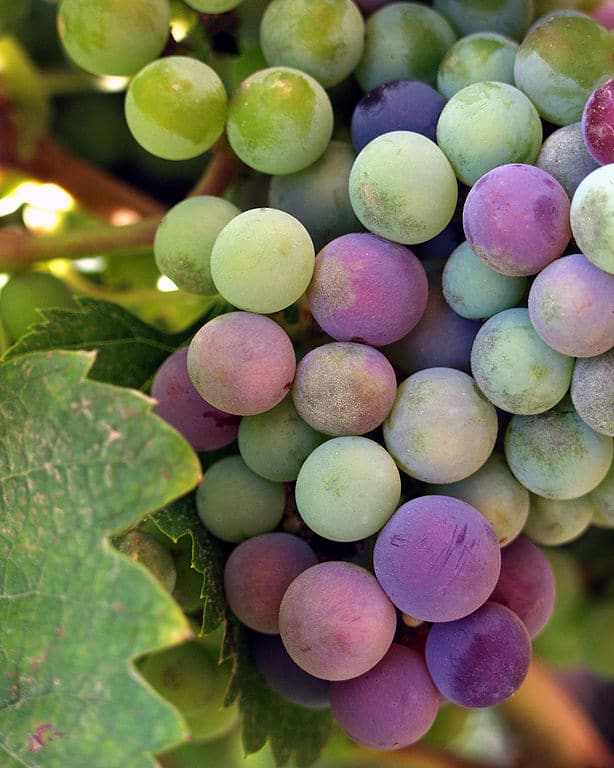Grapes:
What are they?, history, cultivation, nutritional value, uses, recipes, and more...
Grapes are the fruit of the grapevine plant. They are a fruit with white or purple flesh, sweet in taste, and grow in tight clusters known as bunches or grapes, ranging from six to three hundred grapes. They have multiple uses, including consumption as fresh fruit, preservation, raisins, and primarily as raw material for wine production. Currently, Peru is the third-largest exporter of grapes in the world.
Índice
What are Grapes?
Grapes are the fruit of the vine, a semi-woody or climbing plant that can grow up to 30 meters if left unpruned and allowed to grow freely, but is usually pruned to a bush of 1 meter.
The vine’s trunk is twisted and can measure up to 6 meters. It has a rough and thick bark with young branches, called canes, that are flexible and knotty. Its alternate, lobed, and large leaves can measure up to 14 by 12 cm, and its flowers are small, hermaphroditic or unisexual, with greenish petals grouped in clusters.
The fruit, the grape, is a spherical edible fruit whose skin can be green, yellowish, pink, orange, white, or purplish, and its flesh is juicy and sweet, containing several seeds. Its size ranges from 12mm to 24mm and varies according to the species. Grapes grow in tight clusters, and the branches that support them climb thanks to tendrils that coil around other plants.
A vineyard refers to land planted with grapevines, and if it is extensive, it is known as a vineyard.
History of Grapes
It is believed that grapevines, and thus grapes, originated in the Caucasus and Western Asia and were already being harvested in the Paleolithic period. Wild grapevines are known to have existed during the Tertiary Age. During the Neolithic period (6000 BC), grape cultivation began in Asia Minor and the Middle East. There is a record dating back to around 4000 BC of the oldest known wine cellar to this day.
While there are hieroglyphs showing that the ancient Egyptians were already familiar with grapevines, it was the Greeks and Romans who further developed viticulture and expanded grape cultivation throughout Europe. It was even included in Greek mythology, where Bacchus was the god of wine, and in the Catholic Bible, where it is part of Jesus’ first miracle, turning water into wine at the Wedding at Cana.
Like many European products, grapes were brought to the American continent by colonizers in the mid-15th and 16th centuries and spread rapidly in America. However, a plague of Latin American origin, phylloxera, contaminated European grape crops and severely affected European viticulture for many years, especially in the late 19th century.
As a result of this plague, European grape growers were forced to create hybrids with American grapevines, which were already resistant to phylloxera, leading to a great reinvention of viticulture as many completely new grape varieties were created.

Common Name of Grapes
| Español | Parra, parra bravía, parra cultivada, parra de uvas, parra silvestre, parral, parras, parreña, parriza, parrucha, parrón, vid, vid común, vid cultivada, vid silvestre, vides, vidueño, viduño, vinagrera, viña, viña roja, viñas, viñedo. |
| Inglés | Grape |
| Italiano | vitigno |
| Francés | cépage, raisin |
| Portugués | uva |
| Chino | 葡萄 |
| Croata | grožđe |
| Checo | hroznové víno |
| Danés | drue |
| Holandés | druif |
| Finlandés | viinirypäle |
| Alemán | Weintraube |
Scientific Name of Grapes
Vitis vinífera
Taxonomy of Grapes
| Reino | Plantae |
| División | Magnoliophyta |
| Clase | Magnoliopsida |
| Orden | Vitales |
| Familia | Vitaceae |
| Género | Vitis |
| Especie | Vitis vinífera L. |
Synonymy of Grapes
Cissus vinífera (L.) Kuntze
Vitis vinifera subsp. sativa Hegi = Vitis vinifera subsp. vinífera L.
Vitis vinifera subsp. sylvestris (C.C.Gmel.) Hegi
Vitis sylvestris C.C.Gmel.
Etymology of Grapes
Grapes: The term “uva” comes from the Latin word “uva,” which specifically refers to the fruit of the grapevine.
Vine: From the Latin word “vitis.” It refers to a perennial and climbing plant.
Habitat of Grapes
- Habitat
Habitat of Grapes
While grapes are believed to be native to southwestern Asia and central and southwestern Europe, they are currently used in all countries with temperate climates.
Grape cultivation is one of the oldest agricultural practices, viticulture, and is widespread worldwide due to being a versatile, useful fruit with relatively simple cultivation requirements. Grapes are quite resistant to frost and cold climates (areas where the average annual temperature does not fall below 9°C), although they do require sufficient accumulated heat during their growing season for proper ripening. It is not a crop that demands high-quality soil; in fact, the best vineyard soils are characterized by being of average or weak fertility. Grapes can be propagated in different ways, and the chosen method usually depends on the intended use, such as by seed, cuttings (the most common method in commercial production), layering, and grafting.
Geographic Distribution of Grapes

Arequipa, Piura, Ica, Lima, Ancash, La Libertad, Lambayeque
Seasonal Availability of Grapes
- January, February, March, September, October, November, December
Varieties of Grapes
There are around 10,000 known grape varieties in the world, of which 13 occupy over one-third of the total vineyard area, and 33 varieties make up 50% of the total.
-
In Peru, the most prevalent varieties in recent years are divided into traditional and export varieties:
Traditional: La Borgoña La Italia
-
Export
Red Globe Crimson Seedless Thompson Seedless Superior
-
Some of the most widely grown varieties include
Kyoho Cabernet Sauvignon Sultanina Merlot Tempranillo Airen Chardonnay Syrah Red Globe Garnacha Tinta / Grenache Noir Sauvignon Blanc Pinot Noir / Blauer Burgunder Trebbiano Toscano / Ugni Blanc
Nutritional Value of Grapes
Among the main nutritional properties of grapes, their antioxidant power stands out, as the skin of black grapes contains resveratrol, a substance that blocks free radicals, which are directly related to aging and cellular degeneration.
Grapes are detoxifying to the liver, improving hepatic problems, and also benefit the kidneys by helping to eliminate uric acid due to their diuretic properties, thus aiding in cases of cystitis.
They promote good artery and heart health, improve vasodilation, and reduce the risk of thrombosis. Grapes help lower blood pressure due to their high potassium content, making them suitable for people with hypertension.
Their high vitamin K content aids in blood clotting, and thanks to anthocyanins, they are excellent for preventing degenerative eye diseases such as cataracts and maintaining visual acuity.
Grapes have anti-inflammatory and diuretic properties. They help naturally eliminate retained fluids in the body and facilitate the expulsion of toxins.
Furthermore, grapes help care for the skin and keep it youthful for a longer period.
Health Benefits of Grapes
The main benefits of grapes include their antioxidant power and high vitamin K content.
Contraindications or Side Effects
In general, grapes are a beneficial and safe food. However, there are some possible side effects:
Excessive consumption of grapes could cause diarrhea, stomach discomfort, indigestion, nausea, vomiting, cough, dry mouth, and headaches.
There are known cases of allergic reactions to grapes or grape-based products.
Grapes could increase the risk of bruising and bleeding in people with blood disorders. However, there are not enough reports of this situation in humans.
Grapes may decrease blood clotting, so it is recommended to suspend their consumption at least two weeks before scheduled surgery.
Due to their weight and shape, whole grapes pose a potential choking hazard for children aged 5 years or younger. To reduce this risk, it is advisable to cut the fruits in half or quarters before consumption.
Grapes and raisins are toxic foods for dogs and can cause acute kidney failure and even death within just 24 to 72 hours.
| 10 Porciones por Kilogramo | |
| Tamaño de porción | 100g |
| Cantidad por porción Calorías |
63 |
| Cantidad por 100g | |
| Energía | 265 kJ |
| Grasa Total | 0.1 g |
| Sodio | ● |
| Carbohidratos totales | 18.1 g |
| Carbohidratos disponibles | 17.2 g |
| Fibra Dietaria | 0.9 g |
| Proteínas | 0.2 g |
| Calcio | 6 mg |
| Fósforo | 20 mg |
| Zinc | 0.07 mg |
| Hierro | 2.20 mg |
| Potasio | ● |
| Agua | 81.2 g |
| Cenizas | 0.4 g |
| Vitamina A | 3 μg |
| Tiamina (B1) | 0.05 mg |
| Riboflavina (B2) | 0.04 mg |
| Niacina (B3) | 0.15 mg |
| Vitamina C | 2.20 mg |
| Acido Fólico (B9) | ● |
| β-Caroteno | ● |
| Fuente: Tablas peruanas de composición de alimentos – Centro Nacional de Alimentación y Nutrición – Ministerio de Salud – Perú | |
Derived Products and Ways of Consuming Grapes
Uses of Grapes
The primary use of grapes is culinary. Grapes can be consumed fresh, processed, dried (raisins), and are especially appreciated as an ingredient in winemaking. Another highly valued use of grapes is in medicine, where they stand out for the multiple benefits they provide to the body.
- Culinary
- Medicinal
- Industrial
- Ritual
Culinary Use of Grapes
In addition to being consumed as fresh fruit (table grapes), grapes are gastronomically used in countless dishes, such as desserts, snacks, smoothies, juices, salads, among others.
From traditional to contemporary cuisine, grapes have been utilized as a flexible ingredient in various ways: in sauces, gelatin, yogurt, jam, juices, preserves, cheese boards, etc.
One of their main uses is as raw material for wine production. They are also highly appreciated as a dried food product in the form of raisins.
Medicinal Use of Grapes
Traditionally, grapes have been used as a laxative and diuretic, as well as in cases of weakness or low defenses. Many civilizations have used them as a blood purifier and immune system stimulant.
In Chinese medicine, grapes are also used for asthenic dizziness, hoarseness, palpitations, sweating, rheumatic pains, and burning sensation during urination.
Currently, their main medicinal properties include:
- Promoting better brain health by protecting against acute and chronic neurological diseases.
- Inducing arterial relaxation and other favorable metabolic effects. Their flavonoids, including quercetin, catechin, and anthocyanin, prevent heart disease and cancer.
- Grape juice flavonoids have anticoagulant effects similar to aspirin.
- Grape juice reduces the susceptibility of LDL cholesterol to oxidation.
- Grape seeds contain polyphenols, which are powerful neutralizers of free radicals responsible for skin aging. They are also great for healing and protecting the skin from sun and pollution damage.
- Their high fiber content has a mild laxative effect, making them recommended for consumption with the skin intact in people suffering from constipation.
- Grapes also have a beneficial diuretic effect in cases of gout, kidney stones, high blood pressure, and other conditions associated with fluid retention.
Industrial Use of Grapes
Grapes are mainly used as raw material at an industrial level worldwide for the production of the following products: raisins, juices, wines, and preserves.
In addition, grapes have given rise to enocosmetics, cosmetics that harness the benefits of grapes and wine to create products that help oxygenate and nourish the skin. Grape seeds are highly effective when applied in anti-aging treatments, as they have antioxidant power, regenerative properties, and contain vitamin E.
Regarding the export industry, in December 2020, Peru's grape production totaled 198,232 metric tons, a volume 40.0% higher compared to December 2019 (INEI, 2020). Currently, Peru is considered the third-largest exporter of grapes globally and ranks fourth in production in the region.
Ritual Use of Grapes
The Incas attributed magical powers to quinoa, turning its cultivation and harvest into religious celebrations. However, when the Spanish conquistadors arrived in the Andean countries and learned about the importance of quinoa, they rejected and banned it. It is believed that they acted this way out of fear of the "magical quinoa," as consumption of quinoa and religious ceremonies involving it could give indigenous people extraordinary powers and endanger their conquest.
Currently, quinoa is used in traditional Andean rituals as an offering to Pachamama (Mother Earth), and the "Quinua Mama" festival is still celebrated in Puno. According to Inca traditions, at the beginning of the quinoa harvest in the Andes, ancient Peruvian farmers performed a special invocation to "Quinua Mama," the pre-Hispanic goddess of the grain, to ensure an abundant harvest. This ritual involved toasting the first seeds while girls and women made dolls with quinoa leaves and grains, kept for a year and then burned as a sign of renewal.



